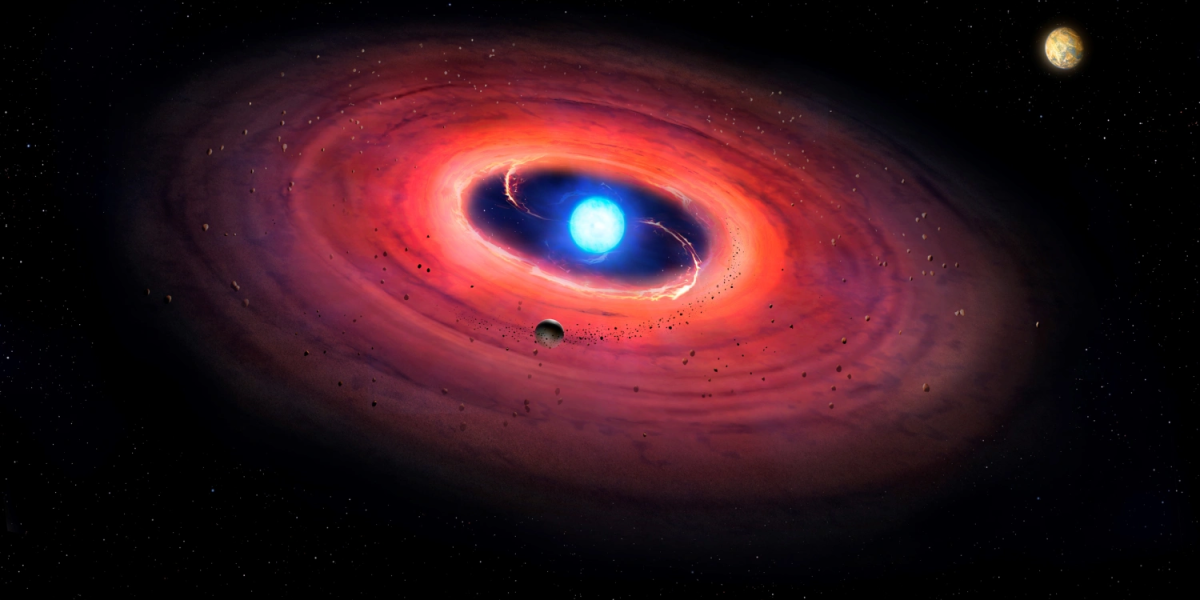The Whirlpool Galaxy in X-ray and optical light (left). The M51-ULS-1 system is shown on the right as an artist’s concept, with the neutron star or black hole syphoning material from its companion star. The planet is obscuring the X-rays generated by the superheated material surrounding the compact object.
Astronomers believe they have found the first extragalactic exoplanet. Residing some 28 million light-years away near the heart of the Whirlpool Galaxy (M51), the binary system M51-ULS-1 consists of either a neutron star or a black hole that’s tangoing with a more standard companion star.

Astronomers used X-ray data rather than more traditional visual observations to locate the distant planet buried in this system. “We are trying to open up a whole new arena for finding other worlds by searching for planet candidates at X-ray wavelengths, a strategy that makes it possible to discover them in other galaxies,” said study lead Rosanne Di Stefano of the Harvard-Smithsonian Center for Astrophysics in a press release.
The study, which was published in Nature Astronomy, looked at three galaxies: M51, M101, and M104. Using the Chandra X-ray Observatory and the European Space Agency’s XMM-Newton, the team targeted more than 200 total star systems within these galaxies. They discovered only one exoplanet in all of those systems.

So far, researchers have mostly used two approaches to identify the over 4,000 confirmed exoplanets. The radial velocity method determines how much a star wobbles when an orbiting planet gently tugs on its stellar host. Even though stars have far more mass than the planets that orbit them, even a small planet can force its star to move a bit, producing an imprint in the star’s light.
In contrast, the transit method makes use of a planet passing in front of its star. This temporarily dims the starlight by a noticeable amount. Even though planets are much smaller than their stars, researchers can measure these small but recognizable fluctuations in brightness.
Although both the radial velocity and transit approaches are clearly effective, they can only discover planets up to around 3,000 light-years from Earth. That’s still well within the boundaries of our Milky Way galaxy, which is about 100,000 light-years across.
To identify the first extragalactic planet, scientists decided to look for passing planets within X-ray binaries. A white dwarf, neutron star, or black hole would draw material from a partner star in these systems. When this material collides with the exotic stellar remnant, it becomes superheated and produces X-rays.
Unlike optical light transits, when a relatively small planet only blocks a tiny amount of starlight, the area where X-rays are created in such binary systems is narrow enough that even a planet can block a significant portion (if not all) of the X-ray light. This means that X-ray transits can be detected at much greater distances than visual transits.
The black hole or neutron star in the M51-ULS-1 system is closely orbited by a star 20 times the mass of the Sun. This makes the system one of M51’s brightest X-ray binaries. Researchers discovered that the X-rays typically emitted by the system dropped to zero for three hours after studying Chandra data. The researchers believe that a Saturn-sized exoplanet is orbiting the compact object at a distance of 19.2 astronomical units (AU; where 1 AU is the average distance between Earth and the Sun). That is roughly twice the distance between Saturn and the Sun.
Of course, an exoplanet isn’t the only possibility for why the X-ray signal was disrupted. A cloud of dust passing in front of an X-ray source can also obscure it. The researchers considered this explanation as well, but concluded that it was less likely than an exoplanet.
Unfortunately, it will take a long time to confirm the extragalactic detection. With such a wide orbit, the candidate won’t pass in front of the source again for another 70 years.
If M51-ULS-1 is a planet, the Saturn-sized object has had a tumultuous history.
The presence of a neutron star or black hole means that once upon a time, the system was home to not just the current companion star, but also another dying star. This doomed star would have used up all of its fuel before exploding as a supernova, bathing any neighboring planets in intense radiation.
And, because the system’s massive current companion star is still kicking, it’s entirely possible that this extragalactic exoplanet might be forced to withstand another nasty supernova in the future.